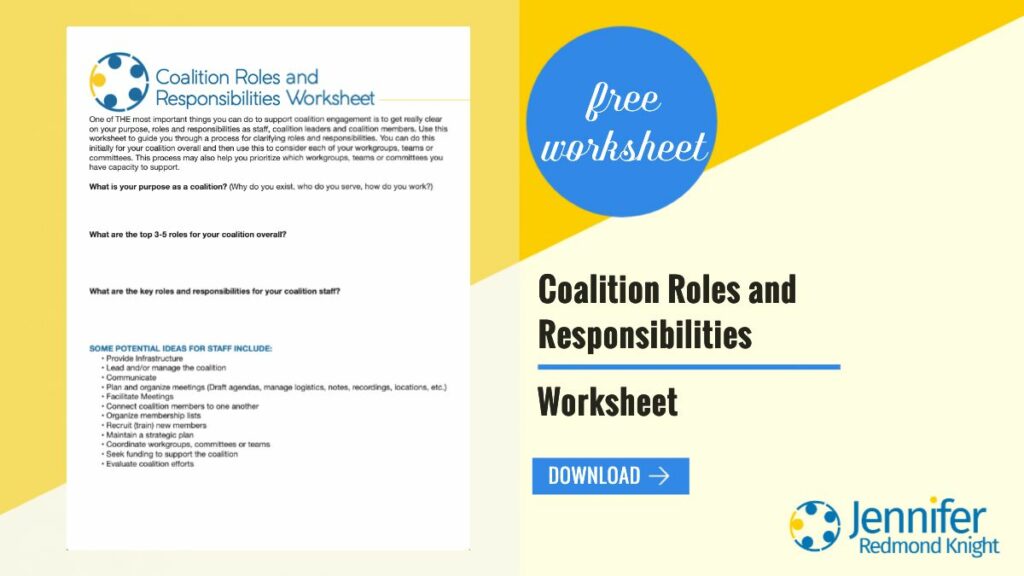Coalitions are often under-funded and under-resourced to accomplish the lofty health, environmental or social goals that align with their purpose. An important role of the coalition is to find ways to catalyze and combine efforts so that collectively the coalition can accomplish much more than could be done by any one organization working independently. In order to combine efforts and yet also honor the unique differences and contributions of the coalition members, coalition leaders must be thoughtful and strategic. Join me this week for three steps on how to combine efforts in a way that is mutually beneficial for the coalition members and the coalition collectively.
Assess resources.
One of the first steps to considering how to combine resources is to assess resources. What resources are currently available to support the work of the coalition? Consider funding, staffing, communication, infrastructure, meeting-related resources, implementation resources and others that may apply to your coalition’s context. Initially, you will likely start with your primary funder, but then you can consider resources that your member organizations may have that align with the work of the coalition that would provide a win-win opportunity. For instance, several years ago, the work of one of the coalitions I was leading was very aligned with a key member organization. The work was so aligned that the staff time for one of those organizational members could be allocated to support the work of building the coalition and health systems changes. We basically had a “bonus” staff member who was paid through a different source but her organization’s goals were so aligned that we were able to synergize our efforts and do more together than we could have done as individuals. Sometimes resources may not be funding or staffing. For instance, some organizations may have access to robust library resources in order to identify evidence-based interventions. Other organizations may have meeting space that is well-suited for coalition gatherings. As you get to know your coalition members and what is important to them, remember to assess resources that may be able to be combined to advance the collective goals of the coalition.
Clarify roles.
An important next step after assessing resources is clarifying roles. If you have a combination of staff and volunteer leaders who are able to support work group or committee implementation, take time to discuss who is doing what to implement the work. Some people may be facilitating the meetings and developing agendas while others are taking notes and maintaining a database of activities. When you are working in the coalition, there are often many assumptions associated with the staff role, the volunteer leader role and the member role. If you are going to combine resources in a way that brings people together positively and does not create duplication or frustration, discussing and setting expectations about roles is extremely important. You may have one idea for your role and someone else has a completely different idea. Communicating and clarifying is an important step if you are going to successfully combine efforts.
Acknowledge contributions.
This is a very important step in combining and catalyzing coalition resources. When staff, leaders, members or partners contribute resources to the work of the coalition, remember to thank them in ways that will resonate with them. For instance, for some people, acknowledging during a meeting and putting a logo on a presentation is an excellent way to reflect their contributions. For others, they would rather have a hand-written thank you note or a personal email showing appreciation for their work. Similar to the clarifying roles step, communicate and discuss the best way(s) to acknowledge contributions. You may have a funder who requests a particular disclosure or you may have a page in your strategic plan or website that lists all the contributors. Check in with your coalition to find out how they want to be acknowledged and remember to keep thanking them for their contributions. And if you experience a situation where you may have missed an opportunity or offended a coalition member, be vulnerable and humble, willing to make a change to make it right. We will not always be able to remember everything, and one of the important aspects of our coalition work is to keep building and maintaining relationships which sometimes involves repairing relationships.
So what about you? What is your next step in considering how to combine resources to catalyze the work of your coalition?
As you consider your coalition combining efforts, one of the aspects I highlighted was clarifying roles. If you would like more support in this area, check out my free Coalition Roles and Responsibilities worksheet.

Photo by Zachary Nelson on Unsplash

